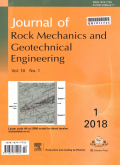- 钛学术文献服务平台 \
- 学术期刊 \
- 基础科学期刊 \
- 天文学、地球科学期刊 \
- 岩石力学与岩土工程学报(英文版)期刊 \
Estimation of the three-dimensional in situ stress field around a large deep underground cavern group near a valley
Estimation of the three-dimensional in situ stress field around a large deep underground cavern group near a valley
基本信息来源于合作网站,原文需代理用户跳转至来源网站获取
摘要:
Understanding three-dimensional (3D) in situ stress field is of key importance for estimating the stability of large deep underground cavern groups near valleys. However, the complete 3D in situ stress fields around large deep underground cavern groups are difficult to determine based on in situ stress data from a limited number of measuring points due to the insufficient representativeness and unreliability of such measurements. In this study, an integrated approach for estimating the 3D in situ stress field around a large deep underground cavern group near a valley is developed based on incomplete in situ stress measurements and the stress-induced failures of tunnels excavated prior to the step excavation of the cavern group. This integrated approach is implemented via four interrelated and progressive basic steps, i.e. inference of the regional tectonic stress field direction, analyses of in situ stress characteristics and measurement reliability, regression-based in situ stress field analysis and reliability assessment, and modified in situ stress field analysis and reliability verification. The orientations and magnitudes of the 3D in situ stress field can be analyzed and obtained at a strategic level following these four basic steps. First, the tectonic stress field direction around the cavern group is deduced in accordance with the regional tectonic framework and verified using a regional crustal deformation velocity map. Second, the reliability of the in situ stress measurements is verified based on the locations and depths of stress-induced brittle failures in small tunnels (such as exploratory tunnels and pilot tunnels) within the excavation range of the cavern group. Third, considering the influences of the valley topography and major geological structures, the 3D in situ stress field is regressed using numerical simulation and multiple linear regression techniques based on the in situ stress measurements. Finally, the regressed in situ stress field is further modified and reverified based on the stress-induced brittle failures of small tunnels and the initial excavation of the cavern group. A case study of the Shuangjiangkou underground cavern group demonstrates that the proposed approach is reliable for estimating the 3D in situ stress fields of large deep underground cavern groups near valleys, thus contributing to the optimization of practical excavation and design of mitigating the instability of the surrounding rock masses during step excavations.

推荐文章
Rapid estimation of soil heavy metal nickel content based on optimized screening of near-infrared sp
Heavy metal
Band extraction
Partial least squares regression
Extreme learning machine
Near infrared spectroscopy
Hyperspectral estimation model of soil Pb content and its applicability in different soil types
Hyperspectral data
Heavy metal
Pb
Estimation
Forest carbon storage in Guizhou Province based on field measurement dataset
Forest carbon storage
Field measurement dataset
Karst landform
Estimation of soil organic carbon storage and its fractions in a small karst watershed
Bare rock rate
Estimation method
soil organic carbon storage
Small watershed
Karst
内容分析
关键词云
关键词热度
相关文献总数
(/次)
(/年)
文献信息
| 篇名 | Estimation of the three-dimensional in situ stress field around a large deep underground cavern group near a valley | ||
| 来源期刊 | 岩石力学与岩土工程学报(英文版) | 学科 | |
| 关键词 | |||
| 年,卷(期) | 2021,(3) | 所属期刊栏目 | |
| 研究方向 | 页码范围 | 529-544 | |
| 页数 | 16页 | 分类号 | |
| 字数 | 语种 | 英文 | |
| DOI | |||
五维指标
引文网络
引文网络
二级参考文献 (79)
共引文献 (0)
参考文献 (23)
节点文献
引证文献 (0)
同被引文献 (0)
二级引证文献 (0)
1977(1)
- 参考文献(1)
- 二级参考文献(0)
1980(1)
- 参考文献(0)
- 二级参考文献(1)
1990(1)
- 参考文献(1)
- 二级参考文献(0)
1993(1)
- 参考文献(1)
- 二级参考文献(0)
1996(1)
- 参考文献(1)
- 二级参考文献(0)
1997(1)
- 参考文献(0)
- 二级参考文献(1)
2000(1)
- 参考文献(0)
- 二级参考文献(1)
2001(3)
- 参考文献(0)
- 二级参考文献(3)
2003(8)
- 参考文献(7)
- 二级参考文献(1)
2004(4)
- 参考文献(2)
- 二级参考文献(2)
2006(3)
- 参考文献(0)
- 二级参考文献(3)
2007(1)
- 参考文献(0)
- 二级参考文献(1)
2008(7)
- 参考文献(0)
- 二级参考文献(7)
2009(5)
- 参考文献(2)
- 二级参考文献(3)
2010(6)
- 参考文献(1)
- 二级参考文献(5)
2011(10)
- 参考文献(1)
- 二级参考文献(9)
2012(7)
- 参考文献(1)
- 二级参考文献(6)
2013(8)
- 参考文献(1)
- 二级参考文献(7)
2015(5)
- 参考文献(0)
- 二级参考文献(5)
2016(10)
- 参考文献(0)
- 二级参考文献(10)
2017(10)
- 参考文献(2)
- 二级参考文献(8)
2018(4)
- 参考文献(0)
- 二级参考文献(4)
2019(4)
- 参考文献(2)
- 二级参考文献(2)
2021(0)
- 参考文献(0)
- 二级参考文献(0)
- 引证文献(0)
- 二级引证文献(0)
引文网络交叉学科
相关学者/机构
期刊影响力
岩石力学与岩土工程学报(英文版)
主办单位:
中国科学院武汉岩土力学所
中国岩石力学与工程学会
武汉大学
出版周期:
双月刊
ISSN:
1674-7755
CN:
42-1801/O3
开本:
大16开
出版地:
湖北省武汉市武昌区水果湖街小洪山2号
邮发代号:
38-299
创刊时间:
2009
语种:
eng
出版文献量(篇)
931
总下载数(次)
0
总被引数(次)
2844
期刊文献
相关文献
推荐文献
- 期刊分类
- 期刊(年)
- 期刊(期)
- 期刊推荐
力学
化学
地球物理学
地质学
基础科学综合
大学学报
天文学
天文学、地球科学
数学
气象学
海洋学
物理学
生物学
生物科学
自然地理学和测绘学
自然科学总论
自然科学理论与方法
资源科学
非线性科学与系统科学
岩石力学与岩土工程学报(英文版)2022
岩石力学与岩土工程学报(英文版)2021
岩石力学与岩土工程学报(英文版)2020
岩石力学与岩土工程学报(英文版)2019
岩石力学与岩土工程学报(英文版)2018
岩石力学与岩土工程学报(英文版)2017
岩石力学与岩土工程学报(英文版)2016
岩石力学与岩土工程学报(英文版)2015
岩石力学与岩土工程学报(英文版)2014
岩石力学与岩土工程学报(英文版)2013
岩石力学与岩土工程学报(英文版)2012
岩石力学与岩土工程学报(英文版)2011
岩石力学与岩土工程学报(英文版)2010
岩石力学与岩土工程学报(英文版)2009
岩石力学与岩土工程学报(英文版)2021年第5期
岩石力学与岩土工程学报(英文版)2021年第4期
岩石力学与岩土工程学报(英文版)2021年第3期
岩石力学与岩土工程学报(英文版)2021年第2期
岩石力学与岩土工程学报(英文版)2021年第1期

 免费查重
免费查重










